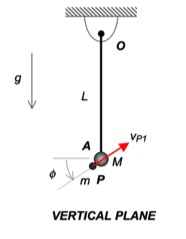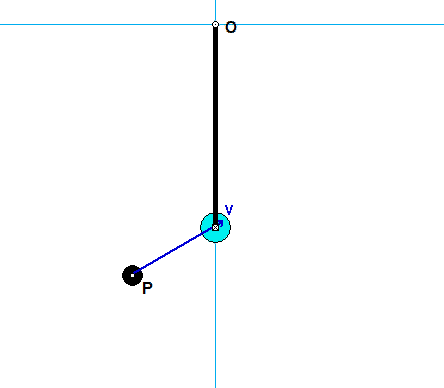| Problem statement Solution video |
DISCUSSION THREAD

Any questions?? Please ask/answer questions regarding this homework problem through the "Leave a Comment" link above.
Discussion

You are asked to investigate the dynamics of this system during the short time of impact of P with A.
- It is suggested that you consider a system made up of A+P+bar (make the system "big").
- Draw a free body diagram (FBD) of this system.
- For this system, linear momentum is NOT conserved since there are non-zero reaction forces at O.
- Furthermore, energy is NOT conserved since there is an impact of P with A during that time.
- From your FBD of the system, you see that the moment about the fixed point O is zero. What does this say about the angular momentum of the system about O during impact? (Answer: It is conserved!)
HINTS:
STEP 1 - FBD: Draw a SINGLE free body diagram (FBD) of the system of A+P+bar.
STEP 2 - Kinetics: Consider the discussion above in regard to conservation of angular momentum about point O. Recall how to calculate the angular momentum about a point for a particle.
STEP 3 - Kinematics: At Instant 2, the P sticks to A: vP2 = vA2.
STEP 4 - Solve.
This problem is similar to 4.D.5. Make sure to use the correct number for g based on the units provided.
You don't have to use the correct number for g. As you are solving for your conservation of angular momentum equation, all you have to do is multiply both sides of the equation by g, and then solve for W2 (angular velocity immediately after P contacts A). When you plug in the variables, you will have the equation in terms of mg, Mg, L, Vp1, and phi, which are given.
Multiplying both sides of the equation by g does not change the value of the equation.
Are we able to say that the moment about O is zero because A and P are particles so their physical dimensions are so small that they are essentially on the same line ?
No, There is still a moment generated about O because there is a force perpendicular to Line OA.
Also, in the H02 part of the equation, will we still have separate A and P components even though they are combined? Or am I able to combine the masses and only use one distance and consider A and P as one body
I believe you can split it into 2 parts, one before the collision where the masses are seperate, and one after where they are the same. As for the distance, You should be able to use the same length.